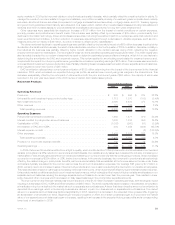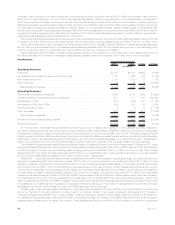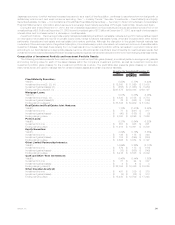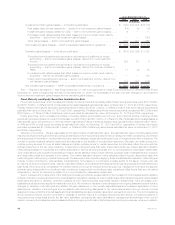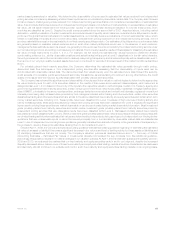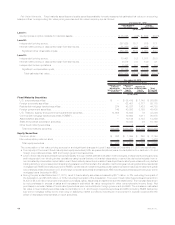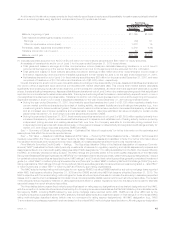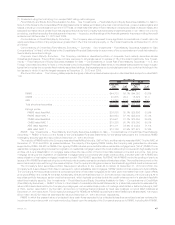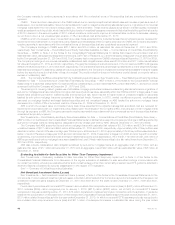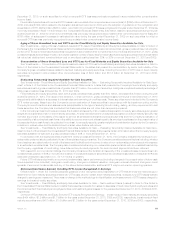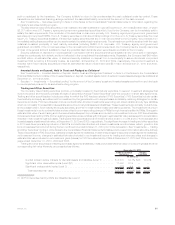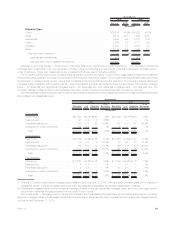MetLife 2010 Annual Report Download - page 46
Download and view the complete annual report
Please find page 46 of the 2010 MetLife annual report below. You can navigate through the pages in the report by either clicking on the pages listed below, or by using the keyword search tool below to find specific information within the annual report.market-based parameters for valuation. We determine the observability of inputs used in estimated fair values received from independent
pricing services or brokers by assessing whether these inputs can be corroborated by observable market data. The Company also follows a
formal process to challenge any prices received from independent pricing services that are not considered representative of estimated fair
value. If we conclude that prices received from independent pricing services are not reflective of market activity or representative of estimated
fair value, we will seek independent non-binding broker quotes or use an internally developed valuation to override these prices. Such
overrides are classified as Level 3. Despite the credit events prevalent since the second half of 2007 described above, including market
dislocation, volatility in valuation of certain investments, and reduced levels of liquidity, which has since moderated but is still present in certain
portions of the global financial markets and in certain asset sectors, our internally developed valuations of current estimated fair value, which
reflect our estimates of liquidity and non-performance risks, compared with pricing received from the independent pricing services, did not
produce material differences for the vast majority of our fixed maturity securities portfolio. Our estimates of liquidity and non-performance risks
are generally based on available market evidence and on what other market participants would use. In the absence of such evidence,
management’s best estimate is used. As a result, we generally continued to use the price provided by the independent pricing service under
our normal pricing protocol and pricing overrides were not material. The Company uses the results of this analysis for classifying the estimated
fair value of these instruments in Level 1, 2 or 3. For example, we will review the estimated fair values received to determine whether
corroborating evidence (i.e., similar observable positions and actual trades) will support a Level 2 classification in the fair value hierarchy.
Security prices which cannot be corroborated due to relatively less pricing transparency and diminished liquidity will be classified as Level 3.
Even some of our very high quality invested assets have been more illiquid for periods of time as a result of the market conditions described
above.
For privately placed fixed maturity securities, the Company determines the estimated fair value generally through matrix pricing,
discounted cash flow techniques or from independent pricing services after assessing that the observability of inputs used can be
corroboratedwithobservablemarketdata.Thediscountedcashflowvaluationsrelyupontheestimatedfuturecashflowsofthesecurity,
credit spreads of comparable public securities and secondary transactions, as well as taking into account, among other factors, the credit
quality of the issuer and the reduced liquidity associated with privately placed debt securities.
The Company has reviewed the significance and observability of inputs used in the valuation methodologies to determine the appropriate
fair value hierarchy level for each of its securities. Based on the results of this review and investment class analyses, each instrument is
categorized as Level 1, 2 or 3 based on the priority of the inputs to the respective valuation methodologies. Certain U.S. Treasury, agency and
government guaranteed fixed maturity securities, certain foreign government fixed maturity securities, residential mortgage-backed secu-
rities (“RMBS”), principally to-be-announced securities, exchange-traded common stock and mutual fund interests, registered mutual fund
interests priced using daily net asset value provided by fund managers included within trading and other securities, certain other securities
classified as trading and other securities which are similar to the above described fixed maturity and equity securities and certain short-term
money market securities, including U.S. Treasury bills, have been classified into Level 1 because of high volumes of trading activity and
narrow bid/ask spreads. Most securities valued by independent pricing services have been classified into Level 2 because the significant
inputs used in pricing these securities are market observable or can be corroborated using market observable information. Most investment
grade privately placed fixed maturity securities and certain below investment grade privately placed fixed maturity securities priced by
independent pricing services that use observable inputs have been classified within Level 2. Distressed privately placed fixed maturity
securities have been classified within Level 3. Below investment grade privately placed fixed maturity securities and less liquid securities with
very limited trading activity where estimated fair values are determined by independent pricing services or by independent non-binding broker
quotations that use unobservable inputs or cannot be derived principally from or corroborated by observable market data, are classified as
Level 3. Use of independent non-binding broker quotations generally indicates there is a lack of liquidity or the general lack of transparency in
the process to develop these price estimates causing them to be considered Level 3.
Effective April 1, 2009, the Company adopted accounting guidance that clarified existing guidance regarding (1) estimating the estimated
fair value of an asset or liability if there was a significant decrease in the volume and level of trading activity for these assets or liabilities and
(2) identifying transactions that are not orderly. The Company’s valuation policies as described above and in “— Summary of Critical
Accounting Estimates — Estimated Fair Values of Investments” already incorporated the key concepts from this additional guidance,
accordingly, this guidance results in no material changes in our valuation policies. At April 1, 2009 and at each subsequent quarterly period in
2009 and 2010, we evaluated the markets that our fixed maturity and equity securities trade in and in our judgment, despite the increased
illiquidity discussed above, believe none of these fixed maturity and equity securities trading markets should be characterized as distressed
and disorderly. We will continue to re-evaluate and monitor such fixed maturity and equity securities trading markets on an ongoing basis.
43MetLife, Inc.


